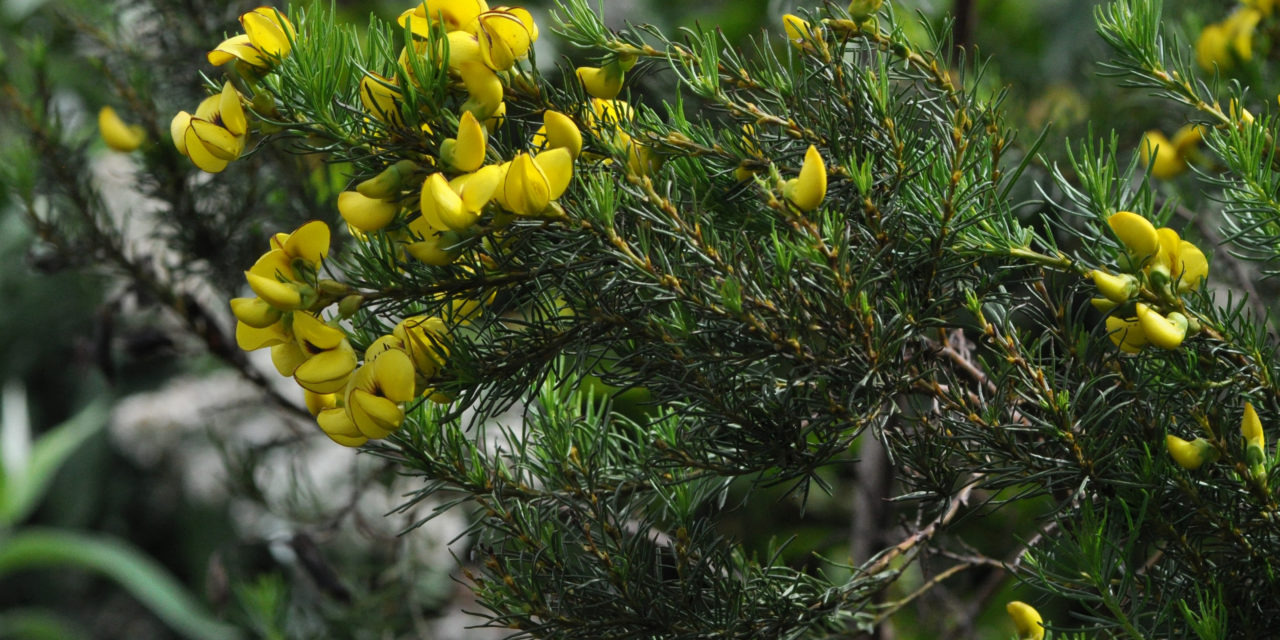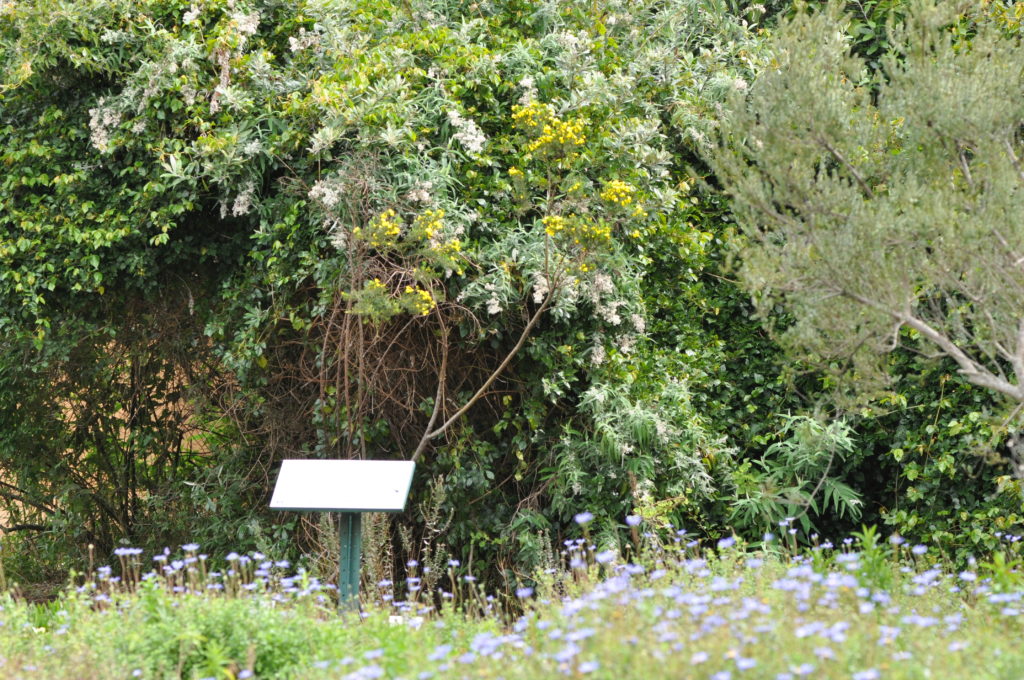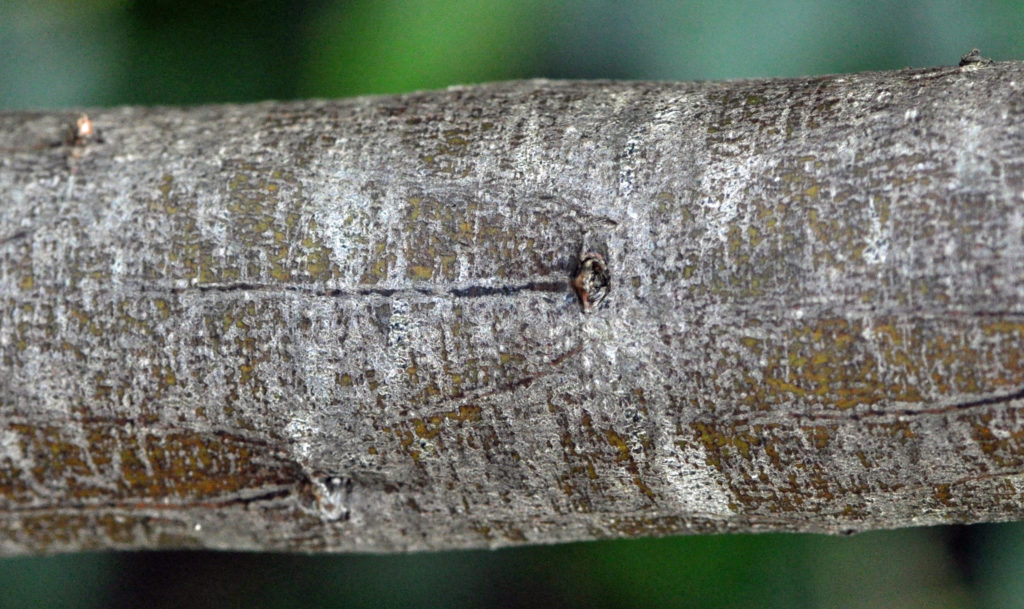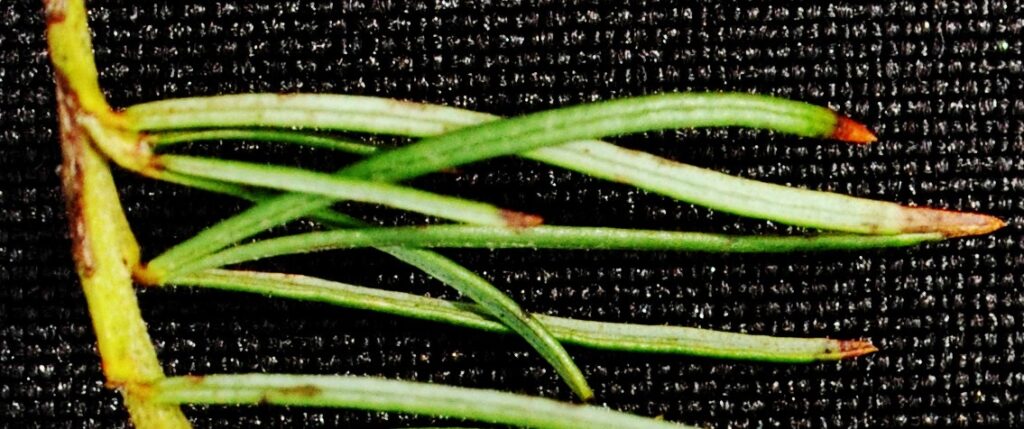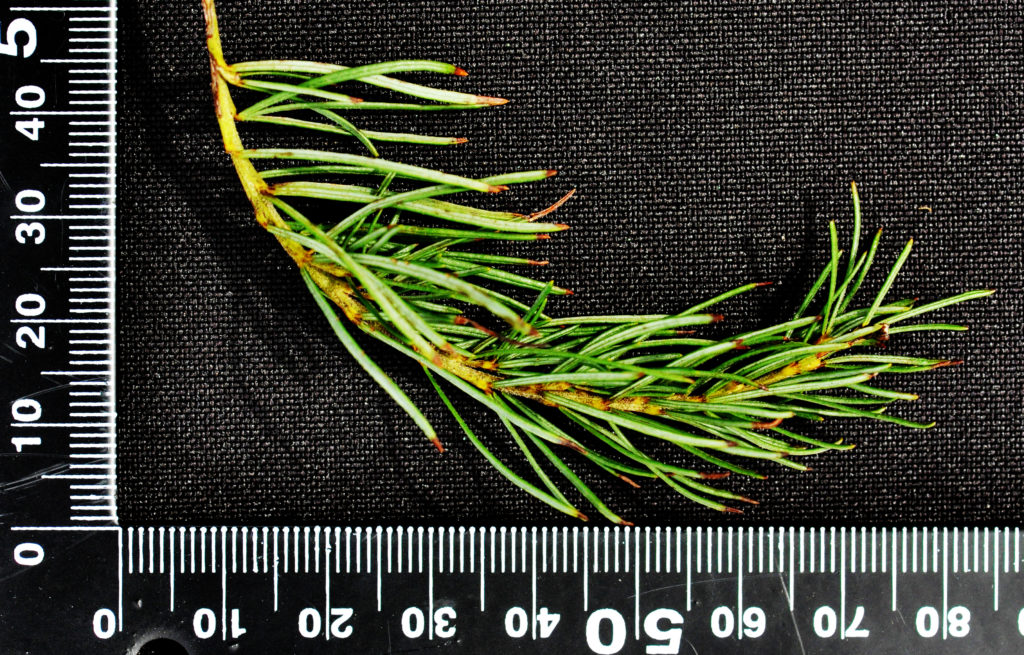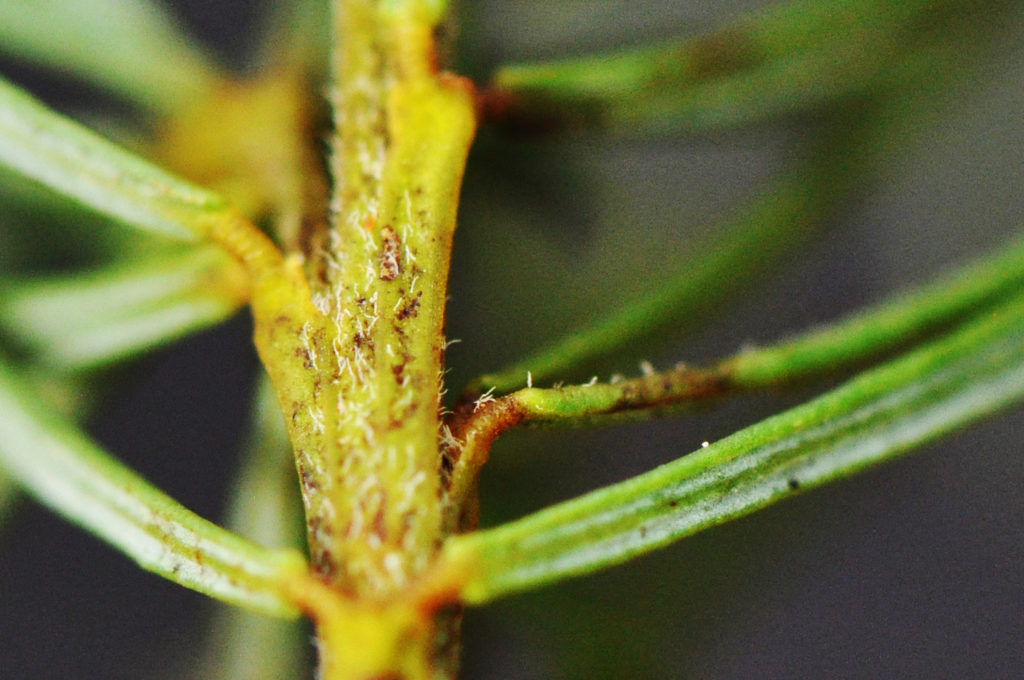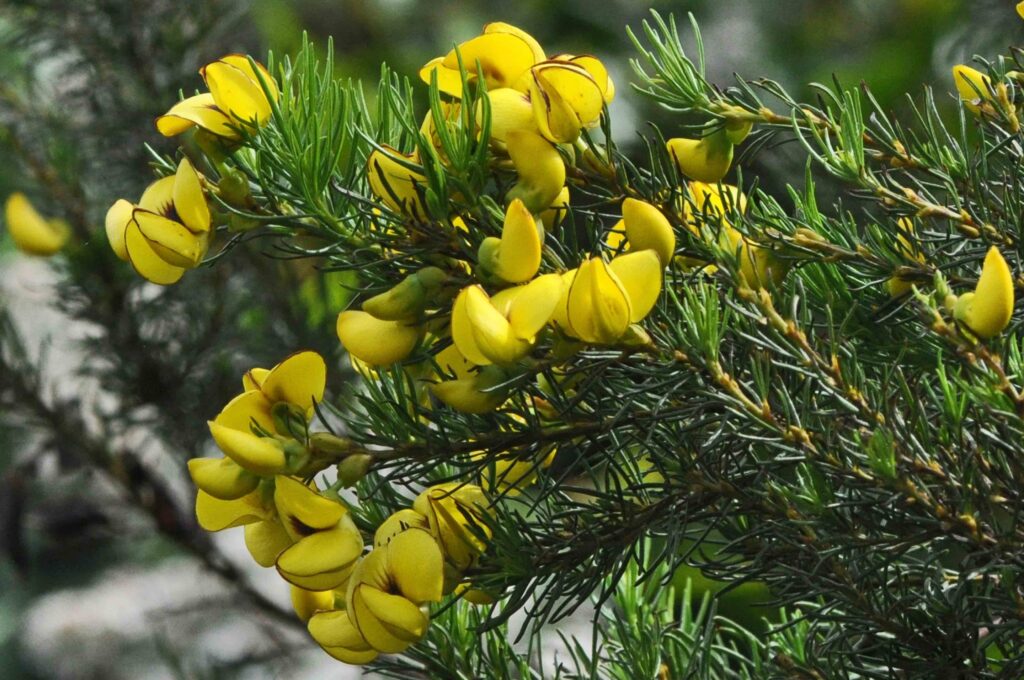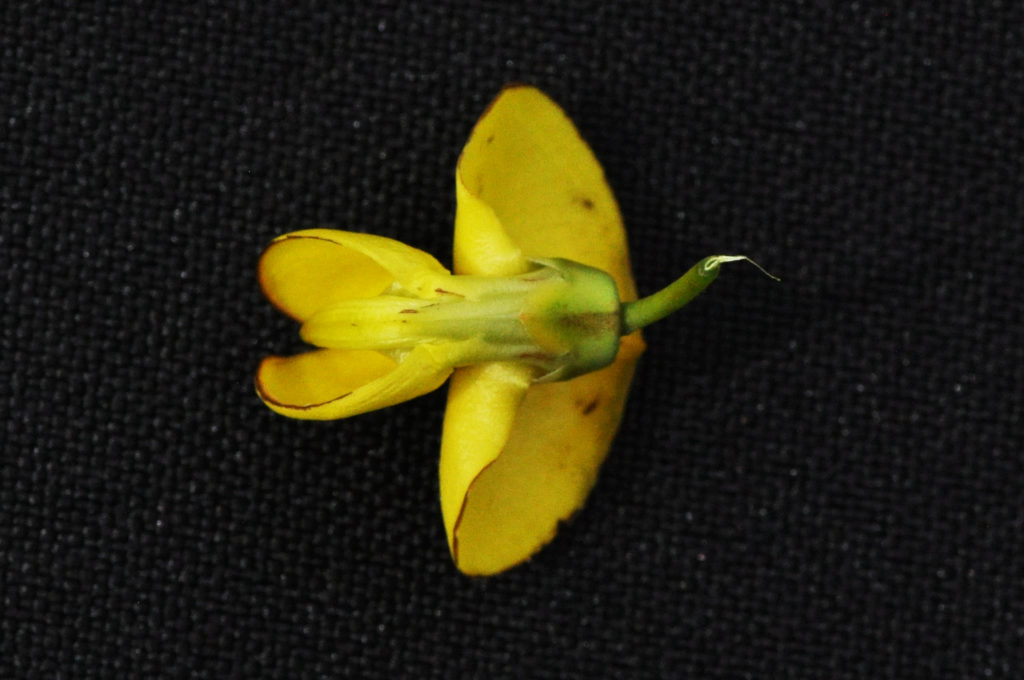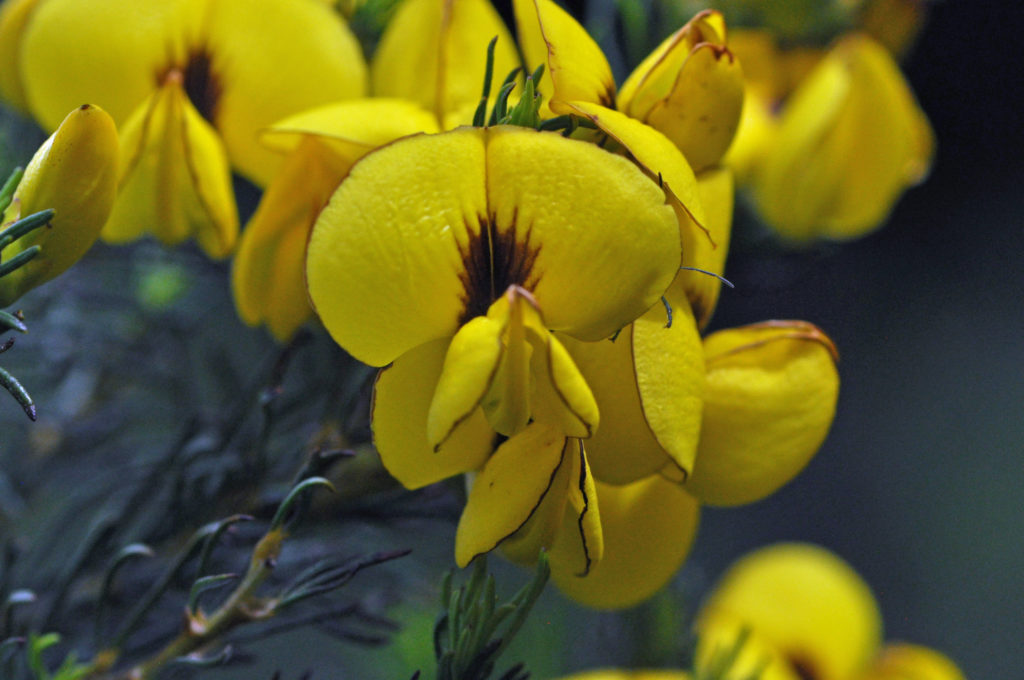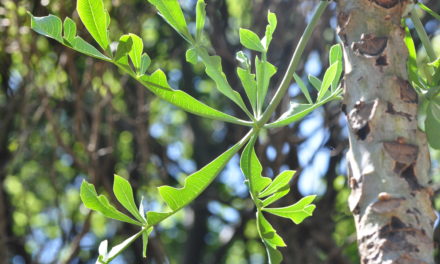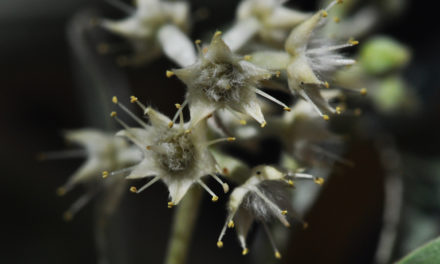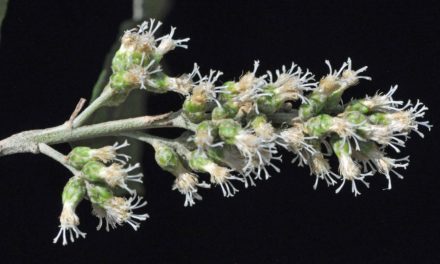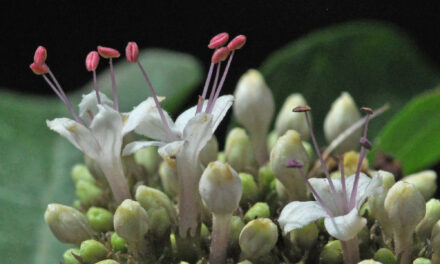Cyclopia meyeriana
General Info
This smooth barked Tree is up to 3m high but is usually a shrub. Young branches may be yellowish. The trifoliate Leaflets are extremely rolled under, lack petioles and up to 30 x 2mm. The solitary, sweetly scented, zygomorphic, bright yellow, pea-type Flowers have 2 basal bracts. The vexillum has a distinctive red central base. The compressed Fruit is an oblong to obliquely ovoid pod containing 3 or more seeds.
Description
Previous Names: Cyclopia montana, Cyclopia sessiliflora.
Common names: (Afr) Heuningtee, Woltee. (Eng) Meyer’s honeybush tea, Meyer’s Cyclopia.
Family: Fabaceae, or Leguminosae (Pea, bean or legume family). After the Orchidaceae and the Asteraceae, the Fabaceae is the third largest Angiosperm (flowering plants) family with 700+ genera and close to 20 000 species. Local Tree genera on this website include Acacia (Vauchellia, Senegalia), Albizia, Bauhinia, Bolusanthus, Burkea, Calpurnia, Colophospermum, Cordyla, Cyclopia, Dichrostachys, Erythrina, Erythrophleum, Faidherbia, Indigofera, Mundulea, Peltophorum, Philenoptera, Piliostigma, Schotia and Xanthocercis. The Fabaceae are recognisable by their fruit and their pinnately compound Leaves. Leaves may also be simple – even bilobed and usually have stipules – some of which may be spinescent. Leaflets are usually entire. Flowers are bisexual and bracteate. Regular flowers usually have 4-5 sepals and the same number of petals. Irregular flowers have 4-5 sepals and 5 or less petals. Stamens have anthers that have 2 pollen sacs and there are usually at least twice the number of stamens as petals – often 10. The superior Ovary has 1 locule containing 1 or more ovules. The Stigma and Style are simple. The single carpel develops into the Fruit, which is usually a pod. The mature pods may dehisce or break into segments. Seeds vary.
Name derivation: Cyclopia – derieved from Greek cyclos a circle and pous a foot. This refers to the intrusive calyx base. Originally, “pous” used to be a Greek unit of length. meyeriana – after Friedrich Karl Meyer, a German botanist (1926–2012). He dedicated part of his life to the study of the genus Malpighia.
Cyclopia: has 20 species that are Endemic (restricted to a particular geographic location) in the Cape floral kingdom of South Africa. They may be tree-like, a much-branched shrub or sprawling shrublets. They may be Suffrutices (having a woody base but shrubby higher up).
Cyclopia: has 20 species that are Endemic (restricted to a particular geographic location) in the Cape floral kingdom of South Africa. They may be tree-like, a much-branched shrub or sprawling shrublets. They may be Suffrutices (having a woody base but shrubby higher up).
Conservation: National Status: L C (Least Concern). Assessed: 2011 (D. Raimondo).
Tree
This plant is usually an erect branched shrub or a small Tree up to 3m high. They usually occur in the altitude range from 1 000 to 1 800m. The Bark is smooth and grey (photo 956) and young branchlets may be yellowish (photo 960 – under Leaves).
- 996. 2018/09/15. Kirstenbosch NBG. Photo: David Becking.
- 956. 2018/09/15. Kirstenbosch NBG. Photo: David Becking.
Leaves
Leaves are trifoliate (compound leaf with 3 Leaflets – photo 960R). Leaflets are linear and rolled backwards becoming almost circular in cross-section (photo 960R). Young leaflets are yellowish green and become dark green as they mature. Leaflets are up to 30 x 2mm (photo 960) and the deep green impressively contrasts with the yellow flowers (photo 957 – under Flowers). A short, broad Petiole (stalk that attaches the leaf blade to the stem – photo 960R & 964), has attached Stipules (basal appendage of the petiole).
- 960R. 2018/09/15. Kirstenbosch NBG. Photo: David Becking.
- 960. 2018/09/15. Kirstenbosch NBG. Photo: David Becking.
- 964. 2018/09/15. Kirstenbosch NBG. Photo: David Becking.
Flowers
The bright yellow sweet-honey scented Flowers are zygomorphic (irregular flowers. When corolla is divisible into 2 equal halves in one plane only). These pea-type flowers are axillary or solitary and occur at the ends of stems (photo 957). They develop in single flowered inflorescences. Paired Bracts (a much-reduced leaf, particularly the small scale-like leaves in a flower cluster or associated with flowers) are fused at the base around the Pedicel (stalk of a single flower – photo 967). The greenish Calyx has a shallow tube. It is truncate (appearing as if cut of at the end – photo 967) and the base is intruse (pushed or projecting inward) and the usually triangular lobes that are slightly longer than the tube. In the Corolla, the rounded upper Vexillum or Standard Petal has a distinctive deep almost star-shaped red central base (photo 959). The 2 oblong Wing Petals have a transverse fold. The 2 joined Keel Petals are incurved and obtusely beaked. (The 10 Stamens have dilated Filaments. The hairless superior Ovary (ovule bearing part of the pistil) is galbrous (hairless). Here the Stigma and Style are simple and there is single carpel (an organ at the centre of a flower, bearing one or more ovules). The carpels develops into the Fruit. (Sep-Dec).
- 957. 2018/09/15. Kirstenbosch NBG. Photo: David Becking.
- 967. 2018/09/15. Kirstenbosch NBG. Photo: David Becking.
- 959. 2018/09/15. Kirstenbosch NBG. Photo: David Becking.
Fruit
The compressed Fruit is a leathery oblong Pod (a usually dehiscent fruit) that has an apex with a distinct beak. The pods are oblong to obliquely ovoid and contain at least 3 Seeds.
Distribution & Ecology
All species of Cycolpia are Endemic (endemism is the ecological state of a species being unique to a defined geographic location) in the Cape Floral Kingdom. This plant occurs in mountain Fynbos (this is a belt of natural shrubland or heathland in the winter rainfall area within the distinctive vegetation of the Western Cape). Flowers are probably pollinated by carpenter bees. Plants are fire survivors and occur in marshy areas and wet slopes from the Cederberg mountains (which lie about 300km to the north of Cape Town) to the Riviersonderend Mountains, which lie about 160km to the east of Cape Town. These plants are adapted and thrive in this typical Mediterranean, winter rainfall climate in an altitude range of approximately 1 000 – 1 800m. Cyclopia meyeriana can survive fires by regenerating after being burned. Fires do not destroy the seeds, which have a very hard testa (seed coat) that protects them and this enhances survival.
Ethnobotany
A form of Honey-bush tea can be made from the leaves, young twigs and flowers. A number of other species of Cyclopia are also used to make tea. This tea lacks caffeine and is usually without tannins and considered to be health giving. The plant is a decretive fynbos plant and can be grown via seeds or cuttings. Before planting, the Seeds must be sclarified (to slit or scratch the outer coat of seeds in order to speed up germination). Plants do best in moist, well-drained, acidic soil – in full sun. This plant requires regular water. Extracts from honey bush tea may help with the treatment of diabetes. Together with Rooibos they are considered types of red tea.
References
Coates Palgrave, M. 2002. Keith Coates Palgrave Trees of Southern Africa. edn 3. Struik, Cape Town.
Raimondo, D. 2011. Cyclopia meyeriana Walp. National Assessment: Red List of South African Plants version . Accessed on 2024/08/21.
http://pza.sanbi.org/cyclopia-meyeriana
https://en.wikipedia.org/wiki/Riviersonderend_Mountains
http://www.rooibos.ch/honeybush_info.html
http://posa.sanbi.org/flora/browse.php?src=SP
http://www.google.com/patents/US20110045108
Nomama Mei. Kirstenbosch National Botanical Garden. May 2016.

